Communication Strategies for Healthcare Professionals Analysis
VerifiedAdded on 2023/04/03
|8
|1792
|352
Report
AI Summary
This report provides a comprehensive analysis of communication strategies essential for health professionals, using a case study of Mr. Tanaka, a patient referred for counseling due to mood concerns. It explores the importance of developing rapport with patients, detailing strategies such as establishing common ground, complementing clients, expressing genuine interest, and creating a conducive environment. The report discusses effective communication techniques like active listening, using simple language, and employing non-verbal cues. It also identifies barriers to effective communication, including language, psychological states, and physical distance, and suggests methods to overcome them. Ethical considerations, particularly autonomy in patient care, are examined. Furthermore, the report emphasizes the significance of interprofessional communication among healthcare teams, addressing challenges like jargon, personal attributes, and hierarchy, while also highlighting ethical concerns such as respect and consent. The conclusion reinforces the central role of communication in delivering quality healthcare and the need for professionals to understand and implement effective communication practices.
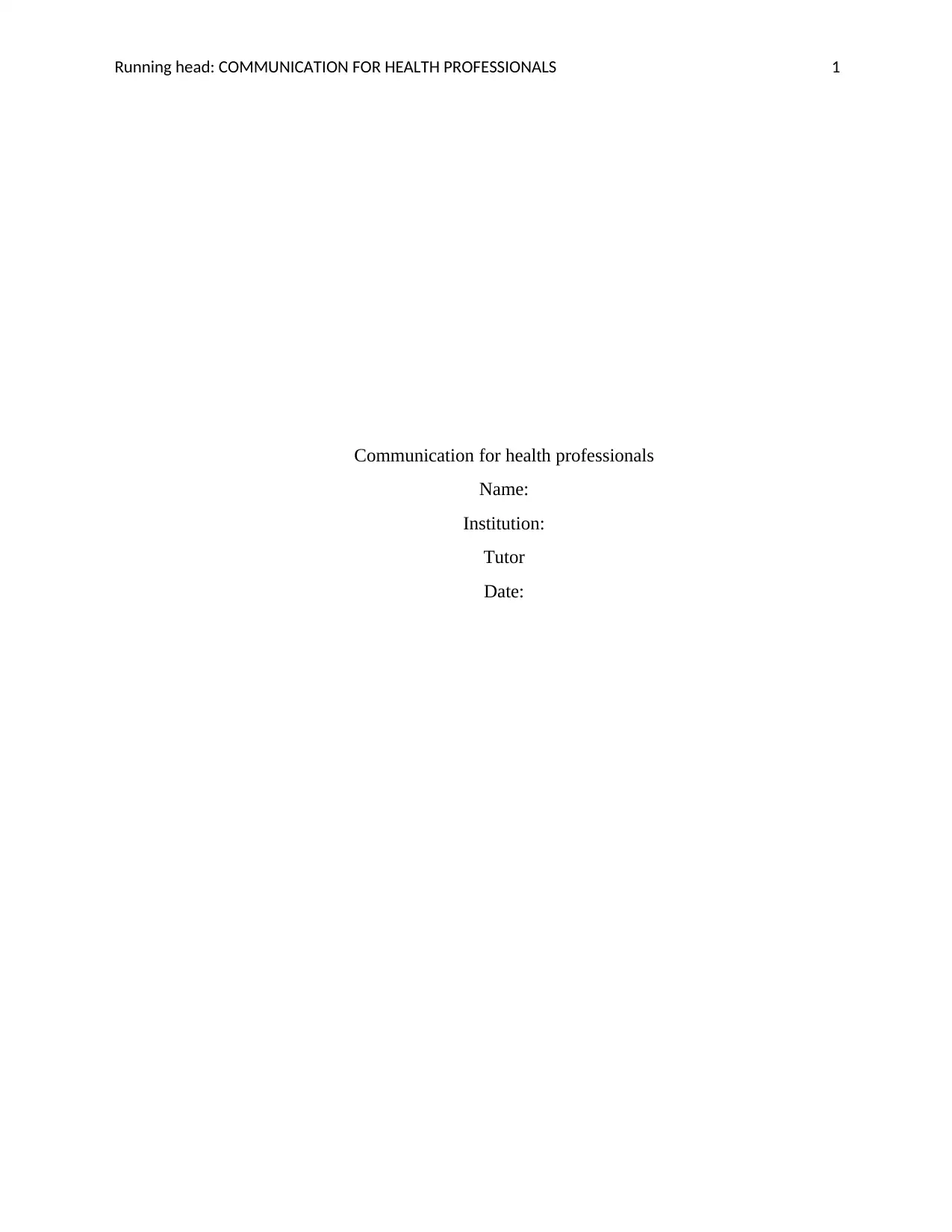
Running head: COMMUNICATION FOR HEALTH PROFESSIONALS 1
Communication for health professionals
Name:
Institution:
Tutor
Date:
Communication for health professionals
Name:
Institution:
Tutor
Date:
Paraphrase This Document
Need a fresh take? Get an instant paraphrase of this document with our AI Paraphraser
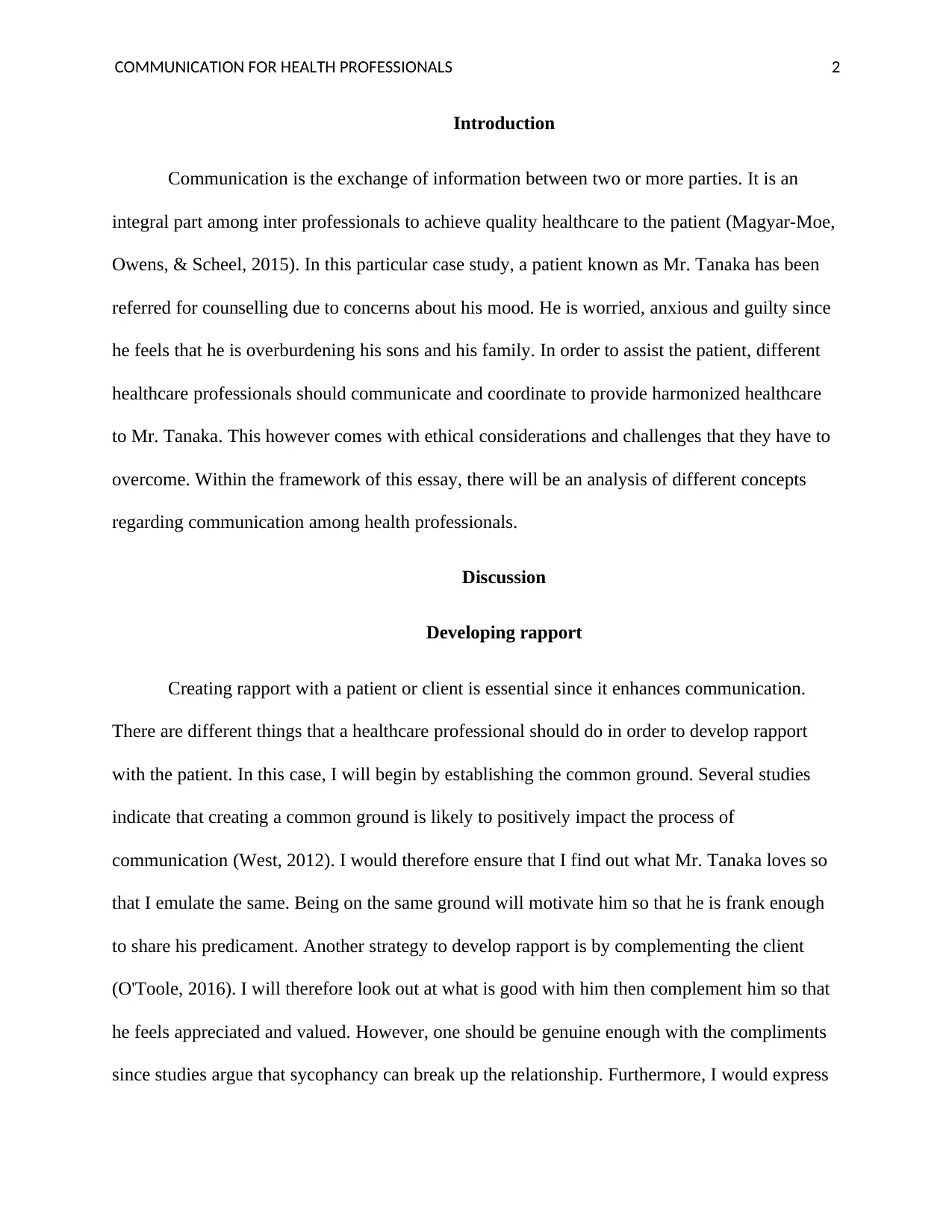
COMMUNICATION FOR HEALTH PROFESSIONALS 2
Introduction
Communication is the exchange of information between two or more parties. It is an
integral part among inter professionals to achieve quality healthcare to the patient (Magyar-Moe,
Owens, & Scheel, 2015). In this particular case study, a patient known as Mr. Tanaka has been
referred for counselling due to concerns about his mood. He is worried, anxious and guilty since
he feels that he is overburdening his sons and his family. In order to assist the patient, different
healthcare professionals should communicate and coordinate to provide harmonized healthcare
to Mr. Tanaka. This however comes with ethical considerations and challenges that they have to
overcome. Within the framework of this essay, there will be an analysis of different concepts
regarding communication among health professionals.
Discussion
Developing rapport
Creating rapport with a patient or client is essential since it enhances communication.
There are different things that a healthcare professional should do in order to develop rapport
with the patient. In this case, I will begin by establishing the common ground. Several studies
indicate that creating a common ground is likely to positively impact the process of
communication (West, 2012). I would therefore ensure that I find out what Mr. Tanaka loves so
that I emulate the same. Being on the same ground will motivate him so that he is frank enough
to share his predicament. Another strategy to develop rapport is by complementing the client
(O'Toole, 2016). I will therefore look out at what is good with him then complement him so that
he feels appreciated and valued. However, one should be genuine enough with the compliments
since studies argue that sycophancy can break up the relationship. Furthermore, I would express
Introduction
Communication is the exchange of information between two or more parties. It is an
integral part among inter professionals to achieve quality healthcare to the patient (Magyar-Moe,
Owens, & Scheel, 2015). In this particular case study, a patient known as Mr. Tanaka has been
referred for counselling due to concerns about his mood. He is worried, anxious and guilty since
he feels that he is overburdening his sons and his family. In order to assist the patient, different
healthcare professionals should communicate and coordinate to provide harmonized healthcare
to Mr. Tanaka. This however comes with ethical considerations and challenges that they have to
overcome. Within the framework of this essay, there will be an analysis of different concepts
regarding communication among health professionals.
Discussion
Developing rapport
Creating rapport with a patient or client is essential since it enhances communication.
There are different things that a healthcare professional should do in order to develop rapport
with the patient. In this case, I will begin by establishing the common ground. Several studies
indicate that creating a common ground is likely to positively impact the process of
communication (West, 2012). I would therefore ensure that I find out what Mr. Tanaka loves so
that I emulate the same. Being on the same ground will motivate him so that he is frank enough
to share his predicament. Another strategy to develop rapport is by complementing the client
(O'Toole, 2016). I will therefore look out at what is good with him then complement him so that
he feels appreciated and valued. However, one should be genuine enough with the compliments
since studies argue that sycophancy can break up the relationship. Furthermore, I would express
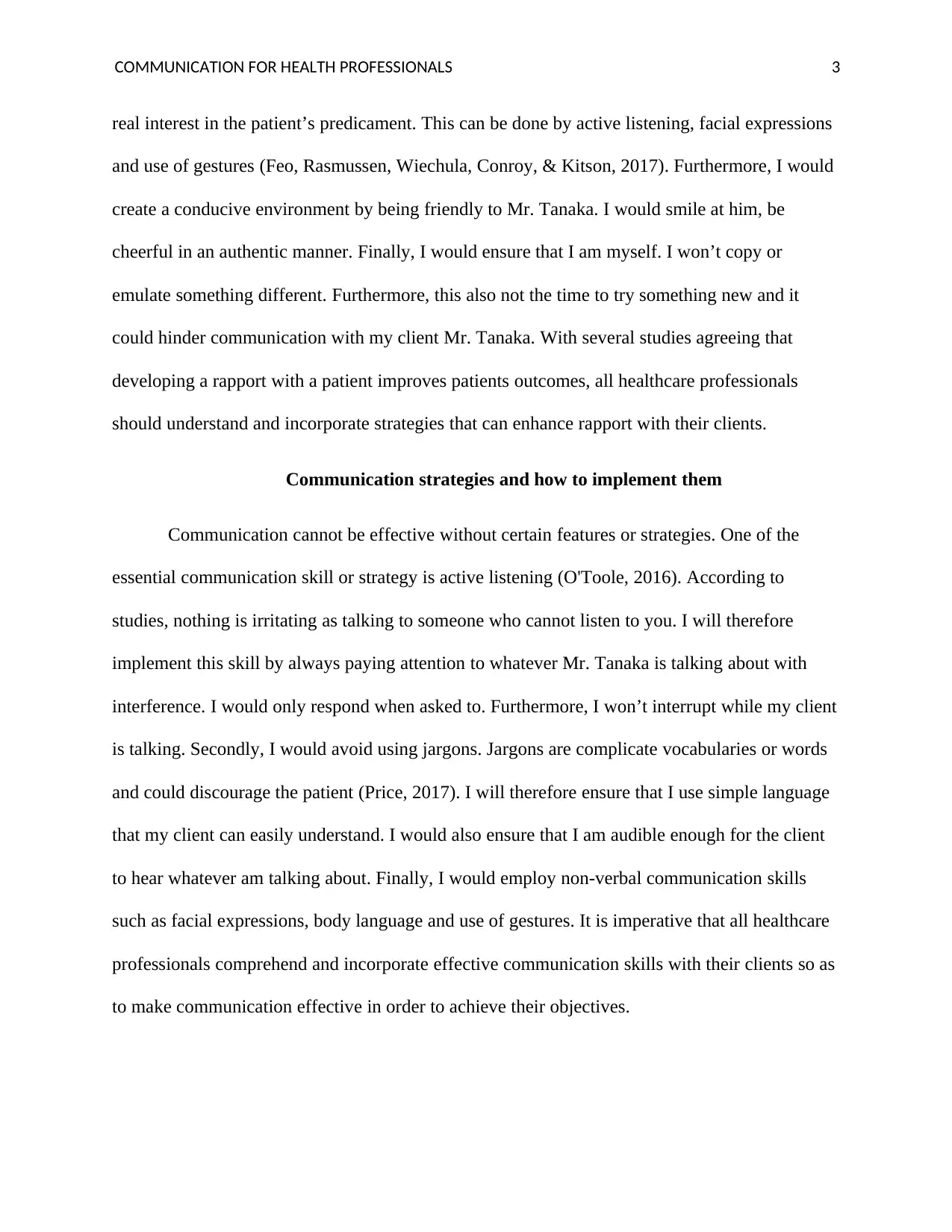
COMMUNICATION FOR HEALTH PROFESSIONALS 3
real interest in the patient’s predicament. This can be done by active listening, facial expressions
and use of gestures (Feo, Rasmussen, Wiechula, Conroy, & Kitson, 2017). Furthermore, I would
create a conducive environment by being friendly to Mr. Tanaka. I would smile at him, be
cheerful in an authentic manner. Finally, I would ensure that I am myself. I won’t copy or
emulate something different. Furthermore, this also not the time to try something new and it
could hinder communication with my client Mr. Tanaka. With several studies agreeing that
developing a rapport with a patient improves patients outcomes, all healthcare professionals
should understand and incorporate strategies that can enhance rapport with their clients.
Communication strategies and how to implement them
Communication cannot be effective without certain features or strategies. One of the
essential communication skill or strategy is active listening (O'Toole, 2016). According to
studies, nothing is irritating as talking to someone who cannot listen to you. I will therefore
implement this skill by always paying attention to whatever Mr. Tanaka is talking about with
interference. I would only respond when asked to. Furthermore, I won’t interrupt while my client
is talking. Secondly, I would avoid using jargons. Jargons are complicate vocabularies or words
and could discourage the patient (Price, 2017). I will therefore ensure that I use simple language
that my client can easily understand. I would also ensure that I am audible enough for the client
to hear whatever am talking about. Finally, I would employ non-verbal communication skills
such as facial expressions, body language and use of gestures. It is imperative that all healthcare
professionals comprehend and incorporate effective communication skills with their clients so as
to make communication effective in order to achieve their objectives.
real interest in the patient’s predicament. This can be done by active listening, facial expressions
and use of gestures (Feo, Rasmussen, Wiechula, Conroy, & Kitson, 2017). Furthermore, I would
create a conducive environment by being friendly to Mr. Tanaka. I would smile at him, be
cheerful in an authentic manner. Finally, I would ensure that I am myself. I won’t copy or
emulate something different. Furthermore, this also not the time to try something new and it
could hinder communication with my client Mr. Tanaka. With several studies agreeing that
developing a rapport with a patient improves patients outcomes, all healthcare professionals
should understand and incorporate strategies that can enhance rapport with their clients.
Communication strategies and how to implement them
Communication cannot be effective without certain features or strategies. One of the
essential communication skill or strategy is active listening (O'Toole, 2016). According to
studies, nothing is irritating as talking to someone who cannot listen to you. I will therefore
implement this skill by always paying attention to whatever Mr. Tanaka is talking about with
interference. I would only respond when asked to. Furthermore, I won’t interrupt while my client
is talking. Secondly, I would avoid using jargons. Jargons are complicate vocabularies or words
and could discourage the patient (Price, 2017). I will therefore ensure that I use simple language
that my client can easily understand. I would also ensure that I am audible enough for the client
to hear whatever am talking about. Finally, I would employ non-verbal communication skills
such as facial expressions, body language and use of gestures. It is imperative that all healthcare
professionals comprehend and incorporate effective communication skills with their clients so as
to make communication effective in order to achieve their objectives.
⊘ This is a preview!⊘
Do you want full access?
Subscribe today to unlock all pages.

Trusted by 1+ million students worldwide
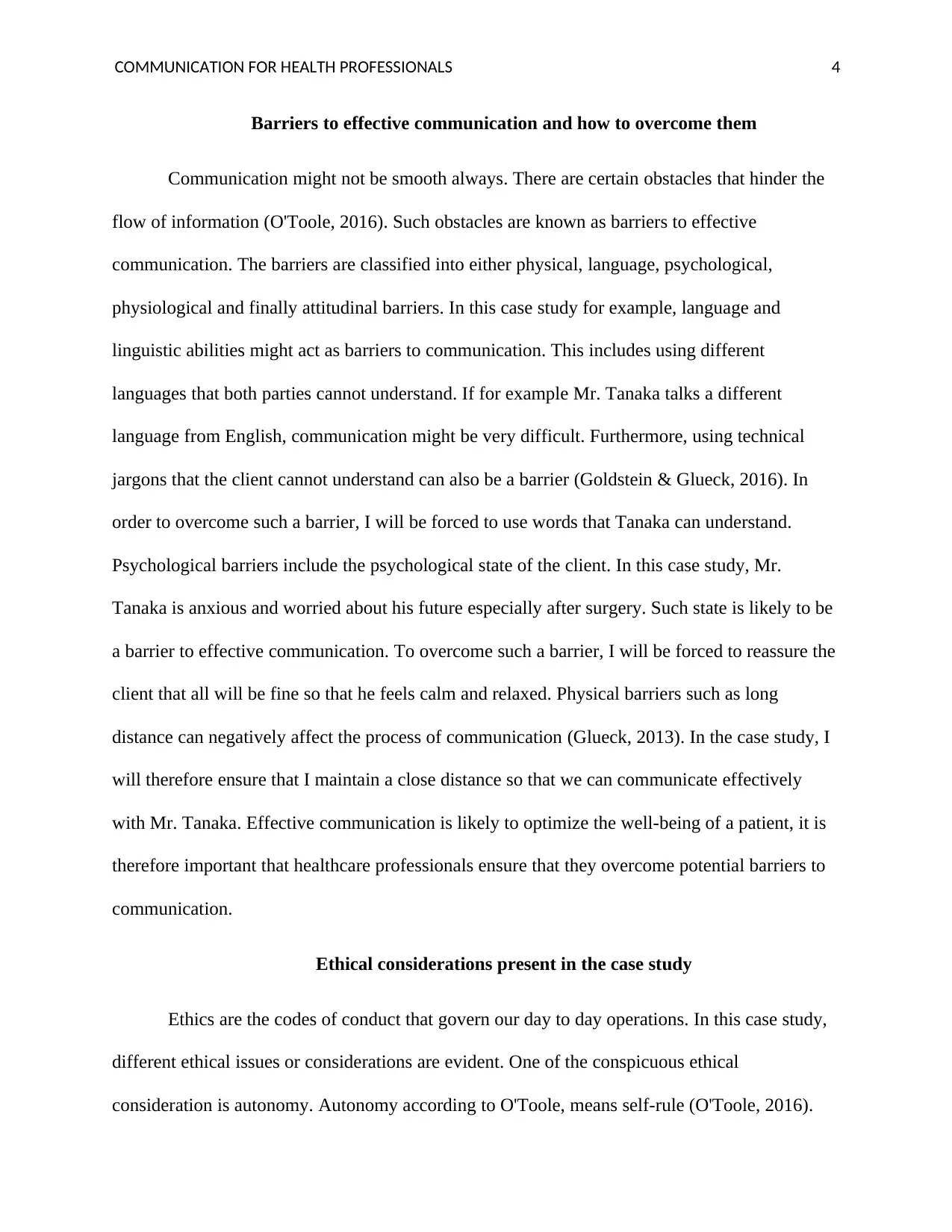
COMMUNICATION FOR HEALTH PROFESSIONALS 4
Barriers to effective communication and how to overcome them
Communication might not be smooth always. There are certain obstacles that hinder the
flow of information (O'Toole, 2016). Such obstacles are known as barriers to effective
communication. The barriers are classified into either physical, language, psychological,
physiological and finally attitudinal barriers. In this case study for example, language and
linguistic abilities might act as barriers to communication. This includes using different
languages that both parties cannot understand. If for example Mr. Tanaka talks a different
language from English, communication might be very difficult. Furthermore, using technical
jargons that the client cannot understand can also be a barrier (Goldstein & Glueck, 2016). In
order to overcome such a barrier, I will be forced to use words that Tanaka can understand.
Psychological barriers include the psychological state of the client. In this case study, Mr.
Tanaka is anxious and worried about his future especially after surgery. Such state is likely to be
a barrier to effective communication. To overcome such a barrier, I will be forced to reassure the
client that all will be fine so that he feels calm and relaxed. Physical barriers such as long
distance can negatively affect the process of communication (Glueck, 2013). In the case study, I
will therefore ensure that I maintain a close distance so that we can communicate effectively
with Mr. Tanaka. Effective communication is likely to optimize the well-being of a patient, it is
therefore important that healthcare professionals ensure that they overcome potential barriers to
communication.
Ethical considerations present in the case study
Ethics are the codes of conduct that govern our day to day operations. In this case study,
different ethical issues or considerations are evident. One of the conspicuous ethical
consideration is autonomy. Autonomy according to O'Toole, means self-rule (O'Toole, 2016).
Barriers to effective communication and how to overcome them
Communication might not be smooth always. There are certain obstacles that hinder the
flow of information (O'Toole, 2016). Such obstacles are known as barriers to effective
communication. The barriers are classified into either physical, language, psychological,
physiological and finally attitudinal barriers. In this case study for example, language and
linguistic abilities might act as barriers to communication. This includes using different
languages that both parties cannot understand. If for example Mr. Tanaka talks a different
language from English, communication might be very difficult. Furthermore, using technical
jargons that the client cannot understand can also be a barrier (Goldstein & Glueck, 2016). In
order to overcome such a barrier, I will be forced to use words that Tanaka can understand.
Psychological barriers include the psychological state of the client. In this case study, Mr.
Tanaka is anxious and worried about his future especially after surgery. Such state is likely to be
a barrier to effective communication. To overcome such a barrier, I will be forced to reassure the
client that all will be fine so that he feels calm and relaxed. Physical barriers such as long
distance can negatively affect the process of communication (Glueck, 2013). In the case study, I
will therefore ensure that I maintain a close distance so that we can communicate effectively
with Mr. Tanaka. Effective communication is likely to optimize the well-being of a patient, it is
therefore important that healthcare professionals ensure that they overcome potential barriers to
communication.
Ethical considerations present in the case study
Ethics are the codes of conduct that govern our day to day operations. In this case study,
different ethical issues or considerations are evident. One of the conspicuous ethical
consideration is autonomy. Autonomy according to O'Toole, means self-rule (O'Toole, 2016).
Paraphrase This Document
Need a fresh take? Get an instant paraphrase of this document with our AI Paraphraser

COMMUNICATION FOR HEALTH PROFESSIONALS 5
This basically means that every adult is at liberty to make any decisions and the decision should
be respected. In this particular case study, Mr. Tanaka is reluctant to take part in the counselling
session. However, he is convinced to decide otherwise. In so doing, the social worker has
breached the principle of autonomy (Butchibabu, Sparano-Huiban, Sonenberg, & Shah, 2016).
Studies note that healthcare professionals should only empower the patients but should not
decide for them. Ethical considerations or principles are controversial and healthcare
professionals only ought to stick to what is expected of them.
Inter professional communication, challenges and ethical consideration
Often, patients suffer from multiple conditions. This also calls for multiple professionals
to communicate and collaborate in order to achieve the well-being of the patient. Studies note
that even though different health professionals offer unique or different approaches, they are
necessary to achieve quality healthcare delivery (Thomson, Outram, Gilligan, & Levett-Jones,
2015). In this case study for example, there are different professionals that can work together to
facilitate recovery of Mr. Tanaka. However, the three essential professionals include a social
worker, a nurse and the doctor. The role of the social worker is to offer advice and
encouragement to the patient so that he does not feel angry, guilty or anxious. The role of the
nurse is to monitor the patient while the doctor administers or delivers the necessary drugs after
surgery (Johnson, 2016). In order for all the professionals to work together in harmony, there
should be communication. This is the reason why studies acknowledge that communication is the
focal point in healthcare. Even though inter professional communication is necessary, it is not
short of different challenges (Foronda, MacWilliams, & McArthur, 2016). One of the biggest
challenges according to Ambrose-Miller & Ashcroft is technical jargon (Ambrose-Miller &
Ashcroft, 2016). Jargon is a language specific to a certain career. The language used by a nurse
This basically means that every adult is at liberty to make any decisions and the decision should
be respected. In this particular case study, Mr. Tanaka is reluctant to take part in the counselling
session. However, he is convinced to decide otherwise. In so doing, the social worker has
breached the principle of autonomy (Butchibabu, Sparano-Huiban, Sonenberg, & Shah, 2016).
Studies note that healthcare professionals should only empower the patients but should not
decide for them. Ethical considerations or principles are controversial and healthcare
professionals only ought to stick to what is expected of them.
Inter professional communication, challenges and ethical consideration
Often, patients suffer from multiple conditions. This also calls for multiple professionals
to communicate and collaborate in order to achieve the well-being of the patient. Studies note
that even though different health professionals offer unique or different approaches, they are
necessary to achieve quality healthcare delivery (Thomson, Outram, Gilligan, & Levett-Jones,
2015). In this case study for example, there are different professionals that can work together to
facilitate recovery of Mr. Tanaka. However, the three essential professionals include a social
worker, a nurse and the doctor. The role of the social worker is to offer advice and
encouragement to the patient so that he does not feel angry, guilty or anxious. The role of the
nurse is to monitor the patient while the doctor administers or delivers the necessary drugs after
surgery (Johnson, 2016). In order for all the professionals to work together in harmony, there
should be communication. This is the reason why studies acknowledge that communication is the
focal point in healthcare. Even though inter professional communication is necessary, it is not
short of different challenges (Foronda, MacWilliams, & McArthur, 2016). One of the biggest
challenges according to Ambrose-Miller & Ashcroft is technical jargon (Ambrose-Miller &
Ashcroft, 2016). Jargon is a language specific to a certain career. The language used by a nurse
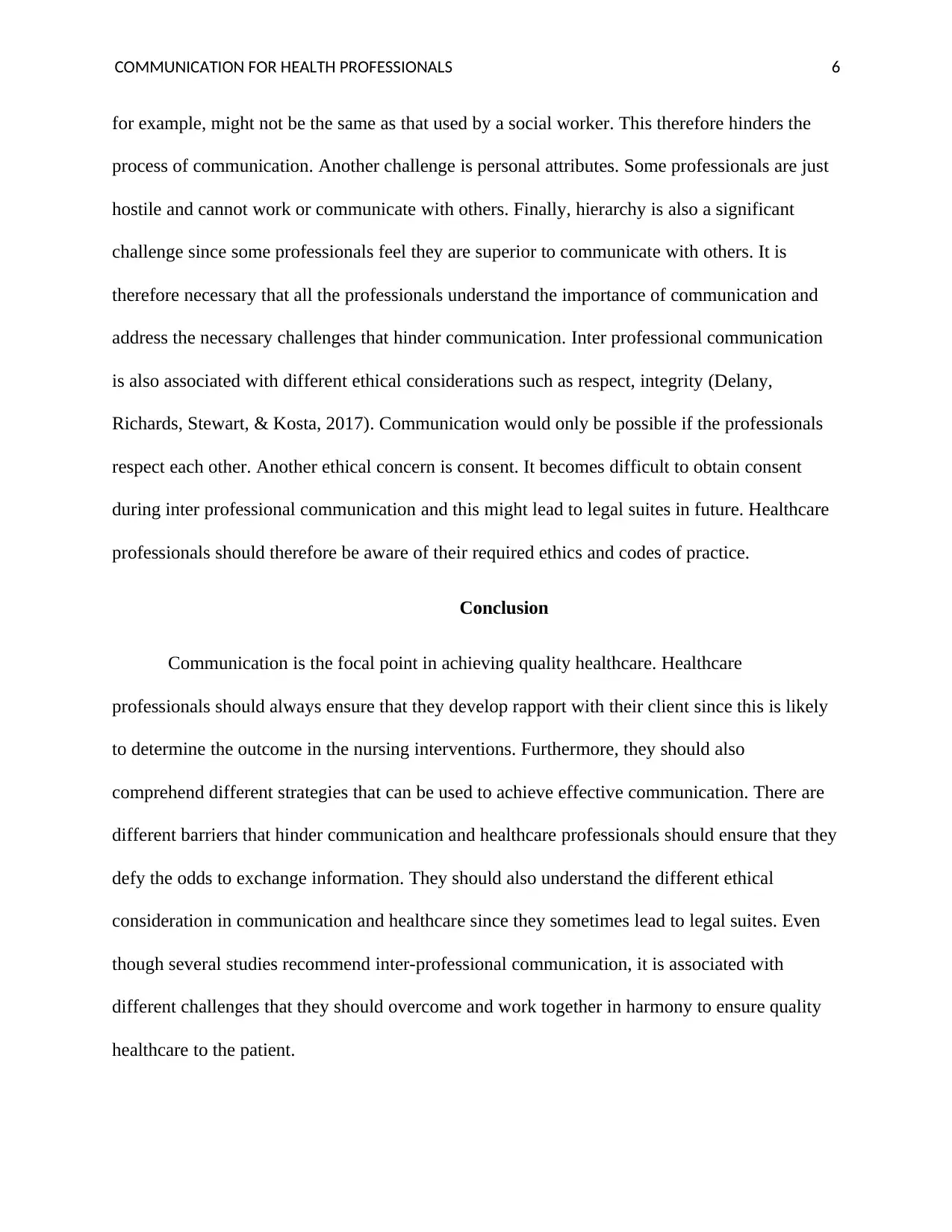
COMMUNICATION FOR HEALTH PROFESSIONALS 6
for example, might not be the same as that used by a social worker. This therefore hinders the
process of communication. Another challenge is personal attributes. Some professionals are just
hostile and cannot work or communicate with others. Finally, hierarchy is also a significant
challenge since some professionals feel they are superior to communicate with others. It is
therefore necessary that all the professionals understand the importance of communication and
address the necessary challenges that hinder communication. Inter professional communication
is also associated with different ethical considerations such as respect, integrity (Delany,
Richards, Stewart, & Kosta, 2017). Communication would only be possible if the professionals
respect each other. Another ethical concern is consent. It becomes difficult to obtain consent
during inter professional communication and this might lead to legal suites in future. Healthcare
professionals should therefore be aware of their required ethics and codes of practice.
Conclusion
Communication is the focal point in achieving quality healthcare. Healthcare
professionals should always ensure that they develop rapport with their client since this is likely
to determine the outcome in the nursing interventions. Furthermore, they should also
comprehend different strategies that can be used to achieve effective communication. There are
different barriers that hinder communication and healthcare professionals should ensure that they
defy the odds to exchange information. They should also understand the different ethical
consideration in communication and healthcare since they sometimes lead to legal suites. Even
though several studies recommend inter-professional communication, it is associated with
different challenges that they should overcome and work together in harmony to ensure quality
healthcare to the patient.
for example, might not be the same as that used by a social worker. This therefore hinders the
process of communication. Another challenge is personal attributes. Some professionals are just
hostile and cannot work or communicate with others. Finally, hierarchy is also a significant
challenge since some professionals feel they are superior to communicate with others. It is
therefore necessary that all the professionals understand the importance of communication and
address the necessary challenges that hinder communication. Inter professional communication
is also associated with different ethical considerations such as respect, integrity (Delany,
Richards, Stewart, & Kosta, 2017). Communication would only be possible if the professionals
respect each other. Another ethical concern is consent. It becomes difficult to obtain consent
during inter professional communication and this might lead to legal suites in future. Healthcare
professionals should therefore be aware of their required ethics and codes of practice.
Conclusion
Communication is the focal point in achieving quality healthcare. Healthcare
professionals should always ensure that they develop rapport with their client since this is likely
to determine the outcome in the nursing interventions. Furthermore, they should also
comprehend different strategies that can be used to achieve effective communication. There are
different barriers that hinder communication and healthcare professionals should ensure that they
defy the odds to exchange information. They should also understand the different ethical
consideration in communication and healthcare since they sometimes lead to legal suites. Even
though several studies recommend inter-professional communication, it is associated with
different challenges that they should overcome and work together in harmony to ensure quality
healthcare to the patient.
⊘ This is a preview!⊘
Do you want full access?
Subscribe today to unlock all pages.

Trusted by 1+ million students worldwide
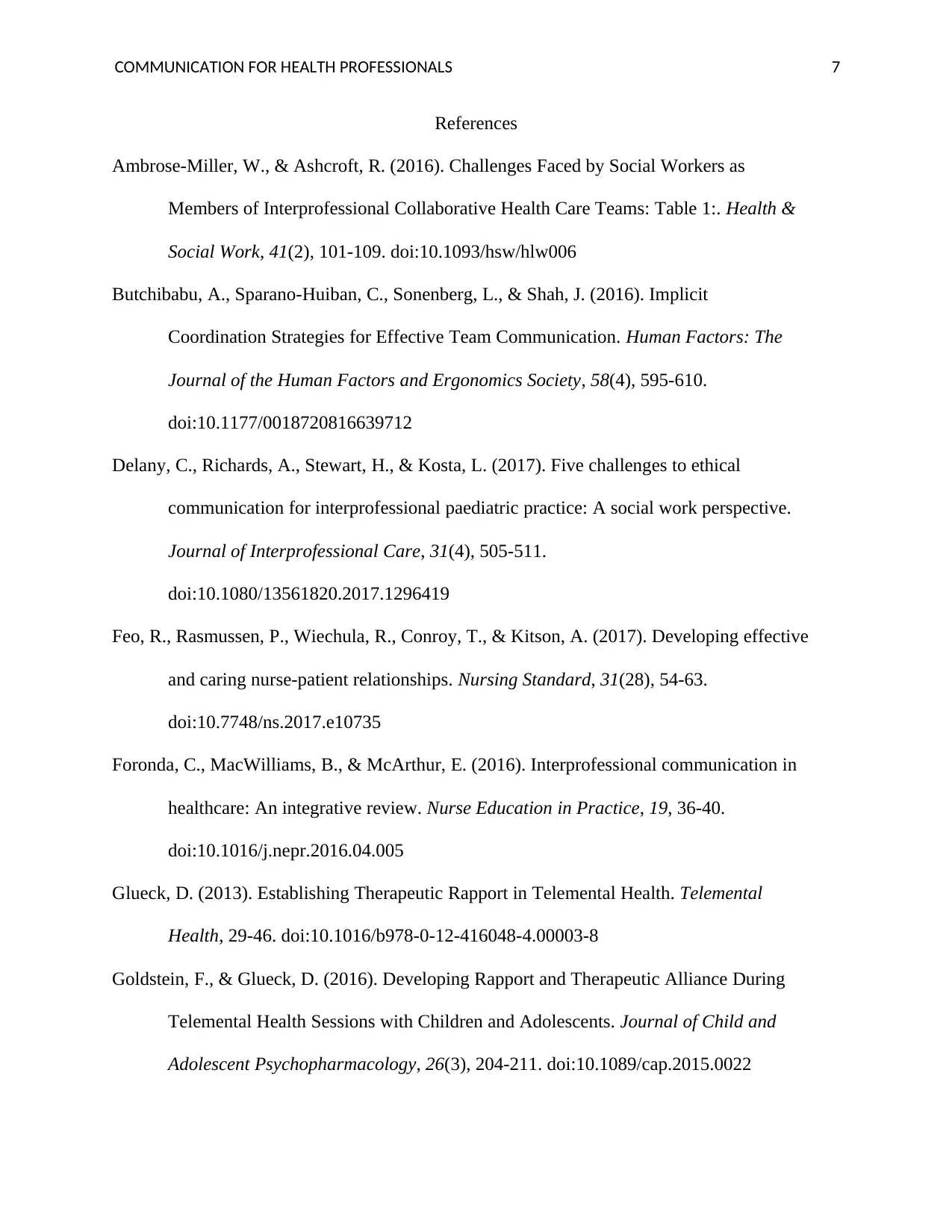
COMMUNICATION FOR HEALTH PROFESSIONALS 7
References
Ambrose-Miller, W., & Ashcroft, R. (2016). Challenges Faced by Social Workers as
Members of Interprofessional Collaborative Health Care Teams: Table 1:. Health &
Social Work, 41(2), 101-109. doi:10.1093/hsw/hlw006
Butchibabu, A., Sparano-Huiban, C., Sonenberg, L., & Shah, J. (2016). Implicit
Coordination Strategies for Effective Team Communication. Human Factors: The
Journal of the Human Factors and Ergonomics Society, 58(4), 595-610.
doi:10.1177/0018720816639712
Delany, C., Richards, A., Stewart, H., & Kosta, L. (2017). Five challenges to ethical
communication for interprofessional paediatric practice: A social work perspective.
Journal of Interprofessional Care, 31(4), 505-511.
doi:10.1080/13561820.2017.1296419
Feo, R., Rasmussen, P., Wiechula, R., Conroy, T., & Kitson, A. (2017). Developing effective
and caring nurse-patient relationships. Nursing Standard, 31(28), 54-63.
doi:10.7748/ns.2017.e10735
Foronda, C., MacWilliams, B., & McArthur, E. (2016). Interprofessional communication in
healthcare: An integrative review. Nurse Education in Practice, 19, 36-40.
doi:10.1016/j.nepr.2016.04.005
Glueck, D. (2013). Establishing Therapeutic Rapport in Telemental Health. Telemental
Health, 29-46. doi:10.1016/b978-0-12-416048-4.00003-8
Goldstein, F., & Glueck, D. (2016). Developing Rapport and Therapeutic Alliance During
Telemental Health Sessions with Children and Adolescents. Journal of Child and
Adolescent Psychopharmacology, 26(3), 204-211. doi:10.1089/cap.2015.0022
References
Ambrose-Miller, W., & Ashcroft, R. (2016). Challenges Faced by Social Workers as
Members of Interprofessional Collaborative Health Care Teams: Table 1:. Health &
Social Work, 41(2), 101-109. doi:10.1093/hsw/hlw006
Butchibabu, A., Sparano-Huiban, C., Sonenberg, L., & Shah, J. (2016). Implicit
Coordination Strategies for Effective Team Communication. Human Factors: The
Journal of the Human Factors and Ergonomics Society, 58(4), 595-610.
doi:10.1177/0018720816639712
Delany, C., Richards, A., Stewart, H., & Kosta, L. (2017). Five challenges to ethical
communication for interprofessional paediatric practice: A social work perspective.
Journal of Interprofessional Care, 31(4), 505-511.
doi:10.1080/13561820.2017.1296419
Feo, R., Rasmussen, P., Wiechula, R., Conroy, T., & Kitson, A. (2017). Developing effective
and caring nurse-patient relationships. Nursing Standard, 31(28), 54-63.
doi:10.7748/ns.2017.e10735
Foronda, C., MacWilliams, B., & McArthur, E. (2016). Interprofessional communication in
healthcare: An integrative review. Nurse Education in Practice, 19, 36-40.
doi:10.1016/j.nepr.2016.04.005
Glueck, D. (2013). Establishing Therapeutic Rapport in Telemental Health. Telemental
Health, 29-46. doi:10.1016/b978-0-12-416048-4.00003-8
Goldstein, F., & Glueck, D. (2016). Developing Rapport and Therapeutic Alliance During
Telemental Health Sessions with Children and Adolescents. Journal of Child and
Adolescent Psychopharmacology, 26(3), 204-211. doi:10.1089/cap.2015.0022
Paraphrase This Document
Need a fresh take? Get an instant paraphrase of this document with our AI Paraphraser
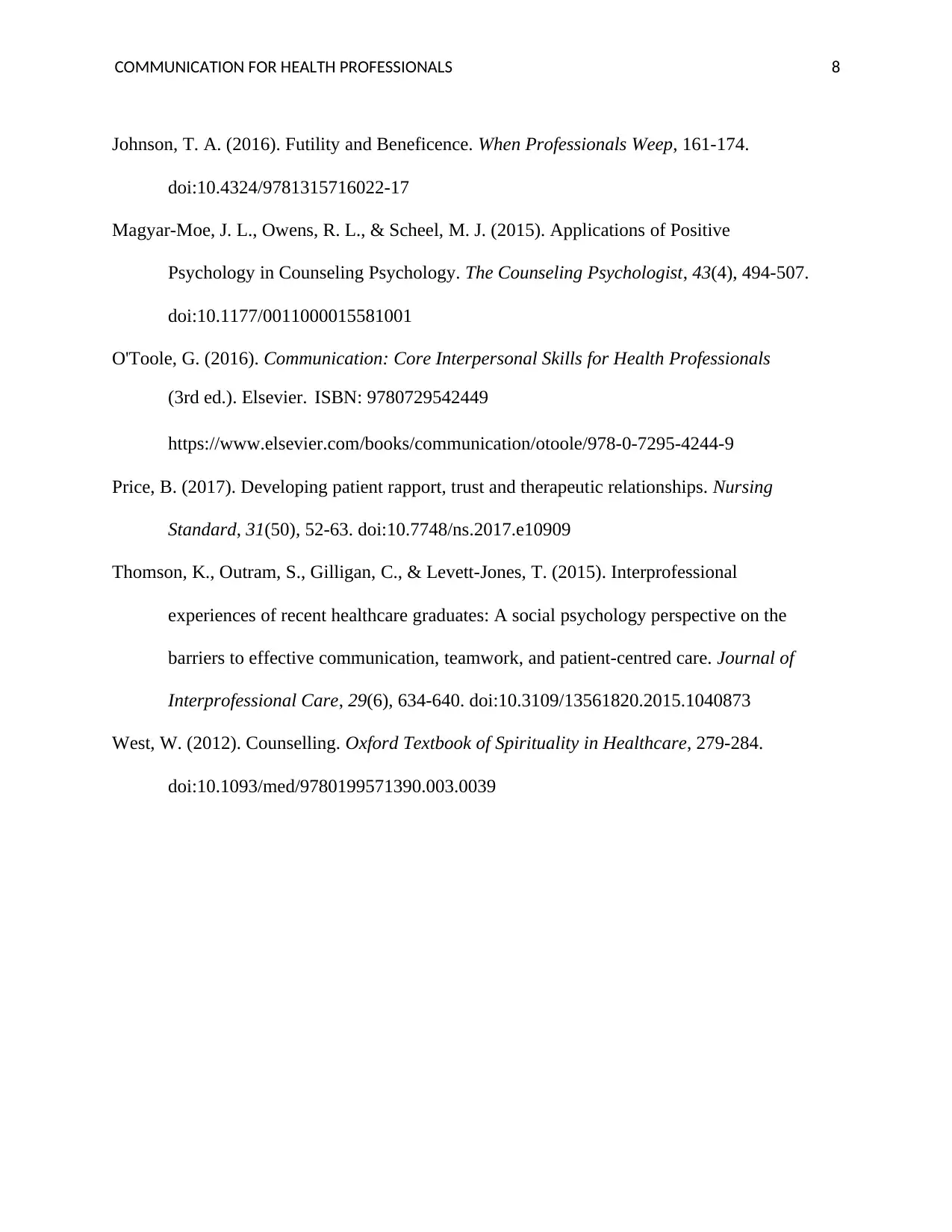
COMMUNICATION FOR HEALTH PROFESSIONALS 8
Johnson, T. A. (2016). Futility and Beneficence. When Professionals Weep, 161-174.
doi:10.4324/9781315716022-17
Magyar-Moe, J. L., Owens, R. L., & Scheel, M. J. (2015). Applications of Positive
Psychology in Counseling Psychology. The Counseling Psychologist, 43(4), 494-507.
doi:10.1177/0011000015581001
O'Toole, G. (2016). Communication: Core Interpersonal Skills for Health Professionals
(3rd ed.). Elsevier. ISBN: 9780729542449
https://www.elsevier.com/books/communication/otoole/978-0-7295-4244-9
Price, B. (2017). Developing patient rapport, trust and therapeutic relationships. Nursing
Standard, 31(50), 52-63. doi:10.7748/ns.2017.e10909
Thomson, K., Outram, S., Gilligan, C., & Levett-Jones, T. (2015). Interprofessional
experiences of recent healthcare graduates: A social psychology perspective on the
barriers to effective communication, teamwork, and patient-centred care. Journal of
Interprofessional Care, 29(6), 634-640. doi:10.3109/13561820.2015.1040873
West, W. (2012). Counselling. Oxford Textbook of Spirituality in Healthcare, 279-284.
doi:10.1093/med/9780199571390.003.0039
Johnson, T. A. (2016). Futility and Beneficence. When Professionals Weep, 161-174.
doi:10.4324/9781315716022-17
Magyar-Moe, J. L., Owens, R. L., & Scheel, M. J. (2015). Applications of Positive
Psychology in Counseling Psychology. The Counseling Psychologist, 43(4), 494-507.
doi:10.1177/0011000015581001
O'Toole, G. (2016). Communication: Core Interpersonal Skills for Health Professionals
(3rd ed.). Elsevier. ISBN: 9780729542449
https://www.elsevier.com/books/communication/otoole/978-0-7295-4244-9
Price, B. (2017). Developing patient rapport, trust and therapeutic relationships. Nursing
Standard, 31(50), 52-63. doi:10.7748/ns.2017.e10909
Thomson, K., Outram, S., Gilligan, C., & Levett-Jones, T. (2015). Interprofessional
experiences of recent healthcare graduates: A social psychology perspective on the
barriers to effective communication, teamwork, and patient-centred care. Journal of
Interprofessional Care, 29(6), 634-640. doi:10.3109/13561820.2015.1040873
West, W. (2012). Counselling. Oxford Textbook of Spirituality in Healthcare, 279-284.
doi:10.1093/med/9780199571390.003.0039
1 out of 8
Related Documents
Your All-in-One AI-Powered Toolkit for Academic Success.
+13062052269
info@desklib.com
Available 24*7 on WhatsApp / Email
![[object Object]](/_next/static/media/star-bottom.7253800d.svg)
Unlock your academic potential
Copyright © 2020–2025 A2Z Services. All Rights Reserved. Developed and managed by ZUCOL.





